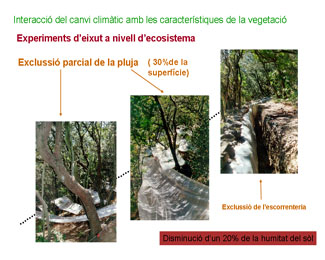Heavy metal accumulation in moss subjected to drought

Since 1999 we were conducting a field drought experiment in an old Quercus ilex Mediterranean forest located in Prades Mountains, with the objective to study the effects of water availability decrease in this Mediterranean community. Six years after the experiment began, we tested the hypothesis that enhanced drought will change C, N, P, K, Ca, Fe, Mg, Mo and S concentrations in the widespread moss Hypnum cupressiforme Hedw. and its capacity to absorb nutrients of soil-borne or air-borne origin.
During the period of study, from 1999 to 2005, the soil moisture in the drought treatment plots was an average 9% lower than the soil moisture in the control plots. Drought increased the K concentration by 10% and C concentration by 6%, and decreased the Fe and Mo concentration by 33% and 18% respectively, and the N/P concentration ratio by 15%. Statistical analysis showed that 69% of the variation in moss elemental composition is explained by drought. Drought increased the enrichment factors of several elements, mainly of P, K, Ca, Mg, S and Mo, relative to bedrock extracts, thus showing that the proportion of those elements absorbed from the atmosphere has been increased by drought.
The results show that drought increased the concentration of elements linked to drought resistance, such as C and K, and decreased the contents of others which are important for plant productivity, such as Mo and Fe. Drought thereby changed moss stoichiometry, and this could also affect the palatability and quite probably the moss-herbivore relationships, the decomposition rates and the productivity capacity.
References
Sardans, J., Peñuelas J. 2008. Drought changes nutrient sources, content and stoichiometry in the bryophyte Hypnum cupressiforme Hedw. growing in a Mediterranean forest. Journal of Bryology 30: 59-65.


